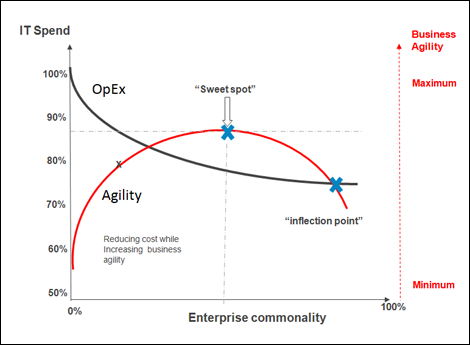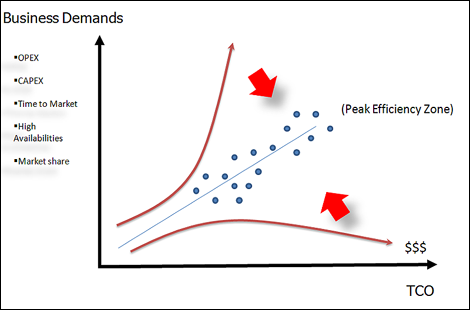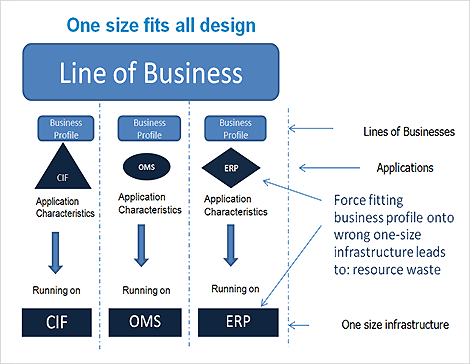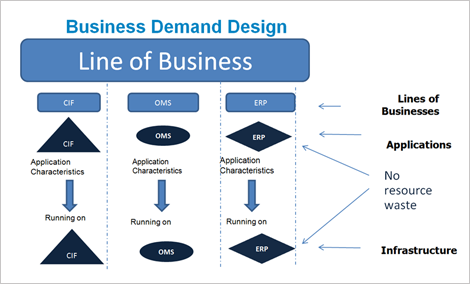Hani Elbeyali is a data center strategist for Dell. He has 18 years of IT experience and is the author of Business Demand Design methodology (B2D), which details how to align your business drivers with your IT strategy.
 HANI ELBEYALI
HANI ELBEYALIDell
In a typical company, “only 36 percent of IT expense is variable, meaning that 64 percent of IT costs are fixed and constant,” according to Rubin Worldwide1. In some organizations, the percentage of IT spending that’s variable is even lower. This means “organizations that are stuck with high fixed IT costs have less flexibility than their competitors to react to changing market conditions and surgically injected IT investments in new business projects.”2 This is called keeping the lights-on syndrome.
Six contributors to keeping the lights-on syndrome:
- CapEx impact on OpEx is 25:75 ratio
- OpEx shows up in the bottom line of the income statement (or the P&L statement). Therefore, it reduces net-profit by 75%; only the depreciation portion of a CapEx piece shows up in income statement.
- CapEx shows up in the balance sheet.
- Realizing RoI normally starts on the third year; the first two years are cumulative costs only.
- About 40-50% of IT projects fail to deliver on its promises.3
- IT supply drives the market, not the enterprise demand. This means vendors are driving data center designs, not customers.
These contributors make it hard for IT strategists to leapfrog beyond “keeping the lights on syndrome.” Moreover, the IT budget needs to shrink 10 percent year over year. Yet, we continue to see some organizations trying to overcome “keeping the lights on syndrome” using one or more of these approaches:
- Reducing technology spending by data center consolidation, virtualization and buying more dense hardware for less, or;
- Reducing workforce by outsourcing, out-tasking, negotiating (RFPs), offshoring and underfunding IT projects;
- Cloud, although promising and should improve OpEx, but with some complications, such as governance, compliance, retention of confidential information and litigation. (In any case, cloud is beyond the discussion of this article.)
Classical OpEx Savings Approaches are Unsustainable
While some of these IT efficiency tactics, such as consolidation, virtualization, outsourcing, off-shoring and under-funding, IT projects are perceived to improve the income statement or "the P&L”, they are not sustainable and don’t hold.
As shown in the graph, initially, OpEx is reduced and business agility improves, but only for short time, which is called “Sweet Zone”. In a couple years, OpEx starts to go up again and business agility goes down; this is showing at the inflection point. With the exception of cloud, these quick solutions are not strategic, and they usually don’t contribute to the long term growth revenue of the company. They impede IT business value creation and IT innovations for the firm, and inflate Total Cost of Ownership (TCO) over the consumption life-cycle time. Therefore, organizations that follow these approaches can’t get a head of the “keeping lights-on” problem.
This vicious cycle causes business people to say, “IT failed us, and we are not sure why IT budget is close to eight percent of total company OpEx?” Even if we assume, some firms could continue to reduce IT budget by 10 percent year over year. Essentially, in a few forthcoming years, the organization will run out of IT budget, and therefore, reach the inflection point of diminishing return of further optimization. This is a clearly unsustainable model.
To put it simply, what’s needed is a new practical approach, striking the balance between:
- Align the firm’s business drivers with IT strategy, i.e. profiling each line of business demands into distinct workloads, executing the workloads over fit for purpose and real time infrastructure. This will effectively squeeze out the wasted data center’s resources.
- Reduce OpEx by spending a little more on planning, designing, automation and orchestration. This effectively reduces the human touch factor during the IT process workflow. This has a positive impact on fixed OpEx, and will transform the organization into real time enterprise running fit for purpose design, or what I call “Business Demand Design.”
What is Business Demand Design?
Business Demand Design (B2D) is an overall framework. It provides abstraction view asserting two facts:
- Each line of business (LoB) has unique sets of demands and IT is the supply for these unique demands; and
- IT architects need to transform data center designs from “one size fits all” (or design for maximum capacity) to custom-fit workloads for each line of business.
The Peak Zone
Organizations that invest the most in IT don’t necessarily outperform their peers. Instead, it’s those companies that make the most effective use of their IT investments that are the biggest return-on-investment beneficiaries.4 Business Demand Design framework is about sustaining the equilibrium between IT, TCO and the business demands.
Comparison between Traditional "One Size Fits All" and Business Demand Design
These charts are comparing two firms. The company depicted in the top chart is running three enterprise applications (ERP, OMS, and CIF). These applications’ characteristics can be demonstrated in distinct diamond, oval, and triangle shapes, respectively. These applications’ characteristics are dragged down into the identical “one size fits all” infrastructure represented in square shapes. Naturally, three distinct shapes cannot fit properly into one model. This leads to much wasted and diluted data center resources and increased operating expense to maintain.
The company on the bottom, although running the same three enterprise applications, utilizes three distinct infrastructures that are simultaneously identical to the applications’ characteristics. This effectively squeezes out the waste, reduces TCO and eliminates diluted resources.
Business Demand Design achieves seven major goals
- Design the infrastructure top-down and bottom-up
- Profile each line of business demands into workloads
- Align your infrastructure according to the business workloads requirements
- Phase out “one size fits all” data center infrastructure, which will help squeeze out much of the wasted resources
- Drive costs down through automation and workflow process improvement
- Avoid the “inflection point,” CapEx spend has X2 impact on fixed OpEx
- Manage risk by enabling risk management from a firm and regulatory perspective
Please note the opinions expressed here are those of the author and do not reflect those of his employer.
Industry Perspectives is a content channel at Data Center Knowledge highlighting thought leadership in the data center arena. See our guidelines and submission process for information on participating. View previously published Industry Perspectives in our Knowledge Library.
1 Dr. Howard Rubin. Rubin World Wide. http://www.rubinworldwide.com/
2 Rubin. Rubin World Wide. (2009). http://www.rubinworldwide.com/files/The_Call_for_Technology_Commons.pdf.
3 Henry A. Lucas. (2005) Information Technology: Strategic Decision Making For Managers.
4 Rubin. Rubin World Wide. http://www.rubinworldwide.com/

 Click for larger image.
Click for larger image. Click to enlarge image.
Click to enlarge image. Click to enlarge.
Click to enlarge. Click to enlarge.
Click to enlarge.


